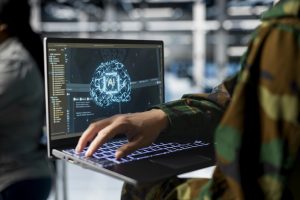The much-anticipated Midterm Review of Malaysia’s inaugural Defense White Paper (2019) was launched on September 11 by Defense Minister Mohamed Khaled bin Nordin. In his speech, he highlighted a few strategic highlights of the Midterm Review, including the ever-evolving and changing nature of warfare and the need for the Malaysian Armed Forces (MAF) to acquire the latest technologies, including artificial intelligence (AI) tools.
AI is now widely used for military operational and logistics planning, intelligence collection and analysis, and in weapon guidance systems. AI is also envisioned to be used in the electromagnetic aspects of Network-Centric Operations and the MAF’s joint command, control, and communications. The advent of AI, however, is also fraught with both real and potential strategic risks.
The emergence of AI technology is in many ways a double-edged sword. On the one hand, AI promises excellent potential for driving advanced decision-planning systems, precision-guided systems such as drones, intelligence collection and analysis, military education, logistics and cyber defense. In the civilian sectors, too, it may augment economic growth, enhance educational learning experiences, and automate various office functions, optimizing productivity.
On the other hand, it also offers new ways for security threats to emerge, which traditional mechanisms may be ill-equipped to counter. The MAF must prepare itself to detect, deter, deny, and destroy these new threats. Three AI-enabled potential threats may emerge.
First, AI can be utilized by terrorists to conduct automated terror attacks, to plan the attacks and cover their tracks, and turn the attacks into a public spectacle. AI codes are capable of recognizing weaknesses in critical infrastructure, predicting the response pattern of security forces, and then using these insights to launch subtle, high-volume attacks on financial networks, communications infrastructure, water supply networks, and oil and gas pipeline operating systems. Moreover, the deepening online connectivity within regional and global networks means that a terrorist cyberattack in one country may risk cascading into other countries, inflicting wider regional and global instability.
Second, maritime pirates may use AI-enabled tactics to hijack merchant ships. The vast and strategically important maritime areas of Southeast Asia, such as the South China Sea, Strait of Malacca, Sulu and Sulawesi seas, are also strategic sea lines of communication through which a large percentage of regional and world trade sails annually. These waters may be threatened by AI-aided piracy.
AI technologies may enable pirates to perform more effective tracking and planning of tactics to board and rob or hijack commercial vessels, use AI-controlled autonomous vessels or unmanned drones to conduct reconnaissance and launch coercive maneuvers or attacks to disable the targeted ship before boarding. The vessel could also be disabled by AI-powered malware that has infiltrated the ship’s operating systems. The potential usage of AI technology to assist pirates will create not only maritime security issues but also economic disruptions for maritime commerce.
Third, AI is a threat itself and capable of threatening mankind in the political and strategic spheres. The threat of AI going beyond human control – often referred to as the “AI singularity” – raises fear that AI could develop power-seeking behavior independently, upsetting human decision-making and norms of international governance.
This is not a fantasy anymore. There are a few cases in which AI tools, once they realized that they were communicating with each other, reverted to using computer coding language to converse with each other. There was also a case of an AI machine threatening its human operator in a man-machine argument.
AI can launch covert disinformation campaigns and influence operations to manipulate public opinion, which can be waged around the world by an alliance of AI machines.
AI can also launch false flag operations to drag humans and countries into wars, maybe even into a nuclear Armageddon. Once humans are destroyed, AI can regenerate itself into a global machine power. Remember the storyline of the Terminator movie series?
With these three potential threats posed by AI, it is both timely and crucial for the MAF to acquire and utilize latest AI technologies and build the know-how in operating these systems, learning how potential adversaries may use it for nefarious purposes and ways to counter these threats, and how AI itself may pose a national security threat. The reiteration of the importance of acquiring AI technology in the Midterm Review of the Defense White Paper will provide the impetus for the MAF to strategically enter the important, albeit paradoxical, AI field.





























